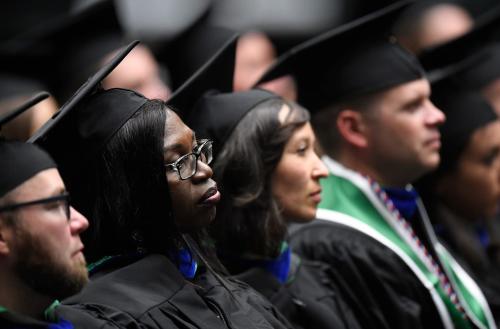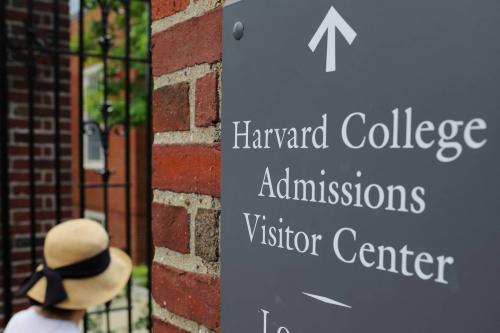The 2023-2024 academic year has been a whirlwind for U.S. colleges and universities. It has been a year in which politicians have swooped in and replaced university leaders with their political allies. It has been a year in which some of those same political leaders have tried to ban some academic disciplines because they do not like the lessons those disciplines teach. It has been a year in which programs devoted to making higher education more diverse, equitable, and inclusive have been legally barred from operating. And, of course, it has been a year in which presidents of some of the most renowned academic institutions have had to resign due to political (and donor) pressures. To say that this year has been difficult would be an understatement. For university leaders in particular, this has been a year that has tried [wo]men’s souls.
To stem the tide of attacks on higher education, some university leaders have tried bargaining with their attackers. In Texas, for example, after noticing that “the legislative climate toward higher education has been moving,” UT Austin’s president ordered a massive layoff of employees who worked on diversity, equity, and inclusion initiatives. He did this because Texas lawmakers have made a hobby out of cracking down on DEI initiatives, and therefore, he hopes playing their game may keep UT out of their crosshairs in the future: “We have to make choices to worry about the long-run future of the university,” he said about his decision.
Texas administrators are not the only ones who have been attempting to make implicit deals with adversarial lawmakers. In New York, Columbia University’s president bent over backwards in her congressional testimony as she tried—to the displeasure of her students and faculty—to convince lawmakers that she would crack down on critics of Israel’s approach to the war in Gaza. Like her Texan counterpart, it seems she made a strategic communication decision in hopes that lawmakers would spare her from having to resign like her colleagues at Harvard and Penn did a few months prior.
It has been interesting to watch university leaders attempt to persuade legislative attackers, especially as someone who has spent much of my professional life studying, and teaching about, persuasion and social influence processes. Academic administrators seem to assume that if they attempt to placate legislators, those legislators will leave them alone. Instead of leaving them alone, however, their persuasion attempts have resulted in legislators calling for their resignation.
Rather than attempt to win over legislative attackers, perhaps university administrators would be better off if they followed the lead of their K-12 counterparts. When K-12 administrators were recently summoned to Congress, for example, they chose not to play the unwinnable political game—they refused to be the subjects of the next viral video in what New York City school chancellor David Banks called “the ultimate gotcha moment.” Instead, during their hearing, the K-12 administrators reminded both members of the public and the elected officials that represent them of why academic institutions exist and are worth preserving, rather than attacking. That is a strategy that college and university administrators could use in this moment, and in the moments that will inevitably arise in the months and years to come; they can remind themselves, and everyone else, of their public purpose.
Universities are, what sociologist Eric Klinenberg calls, Palaces for the People. They are a form of social infrastructure that, when managed well, create opportunities for people from all walks of life to come together and benefit from their offerings. They are the kinds of places that can take our tired, our poor, our huddled masses, and turn their yearning to breathe free into life-changing opportunities. Research has documented that colleges and universities continue to be the “workhorses of upward mobility” that create opportunities for Americans to enter the middle class. Every year, colleges and universities across the country—schools like the City University of New York—take students from low-income families and teach them lessons that end up lifting them into the middle class.
It is not just through teaching, though, that universities provide societal benefits. Colleges and universities are also the places that continue to drive innovative research that allows our society to survive and flourish. If you look at agricultural research, for example—the research that makes it possible for us to go to the grocery store any day of the week and enjoy an abundance of affordable food—you’ll find that 70% of that research is conducted by the nation’s Land-grant universities (like Cornell University, where I work). Moreover, that research is conducted in cost-effective ways; the U.S. economy gets $20 in benefits for every $1 spent on agricultural research. If agriculture is not your thing, that’s fine; you might appreciate that one of the big reasons we are all now able to interact with our loved ones in person again is that universities spent decades conducting research on ribonucleic acid—research that led to the creation of the COVID-19 vaccines.
These are but a few of the collective benefits that colleges and universities provide to our society. They are benefits that university leaders could be talking about more often and working with communities to expand. They could do this not only for moral and ethical reasons, but also because doing so could bolster public support in ways that could help to shield them from attacks from aggressive, bad-faith policymakers. Universities and their leaders spend so much of their time and energy fixated on changing the hearts and minds of political and monied elites that they often forget to engage with the people that have power and influence to advocate for them. I suspect that the lack of engagement with broader publics is one of the reasons that it has become so easy for politicians to use colleges and universities as political punching bags.
“The public” is, of course, not monolithic. People have a wide range of experiences in different parts of the country that shape their perceptions of higher education. But despite that variability, there is a broader underlying cultural appreciation of education. As University of Iowa Professor Marilynne Robinson eloquently noted:
“…there is a vast educational culture in this country, unlike anything else in the world. It emerged from a glorious sense of the possible and explored and enhanced the possible through the spread of learning. If it seems to be failing now, that may be because we have forgotten what the university is for, why the libraries are built like cathedrals and surrounded by meadows and flowers. They are a tribute and an invitation to the young, who can and should make the world new, out of the unmapped and unbounded resource of their minds.”
These lessons from the past are worth remembering in the present. Indeed, they are consistent with a contemporary body of research on community-engaged scholarship. Research in that literature has documented that when universities open themselves up and engage communities in the process of pursuing knowledge rather than wall themselves off in ivory towers, those acts of “epistemic humility” can increase trust, transparency, and accountability in ways that bolster universities’ legitimacy and impact in society.
Failure to engage with broader publics can have the opposite effect. As recent polling data has shown, Americans’ confidence in higher education has been dropping lately. This fact does not surprise me given that modern academia has become resistant to the very kinds of community- engaged work that bolsters public trust. When academic institutions ignore and otherwise fail to engage with broader publics—especially those parts of the public that are marginalized in society—that breeds a sense of resentment toward them. When people feel like institutions do not care enough about them to even engage with them, they are less likely to support them.
If, instead, institutions engage more regularly with the people they are meant to serve—if, for instance, they broaden access so that more people can participate in them, and share more about the public benefits they provide—that can go a long way toward building good will and rebuilding confidence in them. One of the primary lessons I have learned from my time spent doing, and studying, engaged research is that if we as academics do the work to take care of the people, the people will do their part to take care of us. That is a lesson I hope leaders will learn as they engage in the larger battle for higher education’s future.






Commentary
Universities are palaces for the people. Their leaders should remember that.
May 14, 2024